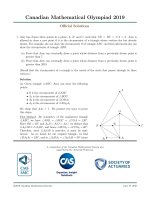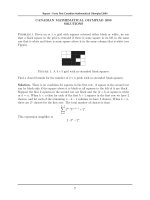Đề thi và đáp án CMO năm 2002
Bạn đang xem bản rút gọn của tài liệu. Xem và tải ngay bản đầy đủ của tài liệu tại đây (68.59 KB, 6 trang )
<span class='text_page_counter'>(1)</span><div class='page_container' data-page=1>
<b>2002 Canadian Mathematical Olympiad</b>
<b>Solutions</b>
1. Let<i>S</i> be a subset of<i>{</i>1<i>,</i>2<i>, . . . ,</i>9<i>}</i>, such that the sums formed by adding each unordered pair of
distinct numbers from<i>S</i>are all different. For example, the subset<i>{</i>1<i>,</i>2<i>,</i>3<i>,</i>5<i>}</i>has this property,
but<i>{</i>1<i>,</i>2<i>,</i>3<i>,</i>4<i>,</i>5<i>}</i> does not, since the pairs<i>{</i>1<i>,</i>4<i>}</i>and <i>{</i>2<i>,</i>3<i>}</i>have the same sum, namely 5.
What is the maximum number of elements that<i>S</i> can contain?
<b>Solution 1</b>
It can be checked that all the sums of pairs for the set<i>{</i>1<i>,</i>2<i>,</i>3<i>,</i>5<i>,</i>8<i>}</i> are different.
Suppose, for a contradiction, that<i>S</i> is a subset of<i>{</i>1<i>, . . . ,</i>9<i>}</i> containing 6 elements such that
all the sums of pairs are different. Now the smallest possible sum for two numbers from <i>S</i> is
1 + 2 = 3 and the largest possible sum is 8 + 9 = 17. That gives 15 possible sums: 3<i>, . . . ,</i>17.
Also there are
à
6
2
ả
= 15 pairs from <i>S</i>. Thus, each of 3<i>, . . . ,</i>17 is the sum of exactly one
pair. The only pair from<i>{</i>1<i>, . . . ,</i>9<i>}</i> that adds to 3 is<i>{</i>1<i>,</i>2<i>}</i> and to 17 is<i>{</i>8<i>,</i>9<i>}</i>. Thus 1<i>,</i>2<i>,</i>8<i>,</i>9
are in<i>S</i>. But then 1 + 9 = 2 + 8, giving a contradiction. It follows that the maximum number
of elements that<i>S</i> can contain is 5.
<b>Solution 2.</b>
It can be checked that all the sums of pairs for the set<i>{</i>1<i>,</i>2<i>,</i>3<i>,</i>5<i>,</i>8<i>}</i> are different.
Suppose, for a contradiction, that <i>S</i> is a subset of <i>{</i>1<i>, . . .</i>9<i>}</i> such that all the sums of pairs
are different and that<i>a</i><sub>1</sub><i>< a</i><sub>2</sub> <i>< . . . < a</i><sub>6</sub> are the members of <i>S</i>.
Since <i>a</i><sub>1</sub>+<i>a</i><sub>6</sub> <i>6</i>=<i>a</i><sub>2</sub>+<i>a</i><sub>5</sub>, it follows that <i>a</i><sub>6</sub><i>−a</i><sub>5</sub> =<i>6</i> <i>a</i><sub>2</sub><i>−a</i><sub>1</sub>. Similarly <i>a</i><sub>6</sub><i>−a</i><sub>5</sub> <i>6</i>=<i>a</i><sub>4</sub><i>−a</i><sub>3</sub> and
<i>a</i><sub>4</sub><i>−a</i><sub>3</sub> <i>6</i>=<i>a</i><sub>2</sub><i>−a</i><sub>1</sub>. These three differences must be distinct positive integers, so,
(<i>a</i><sub>6</sub><i>−a</i><sub>5</sub>) + (<i>a</i><sub>4</sub><i>−a</i><sub>3</sub>) + (<i>a</i><sub>2</sub><i>−a</i><sub>1</sub>)<i>≥</i>1 + 2 + 3 = 6<i>.</i>
Similarly <i>a</i><sub>3</sub><i>−a</i><sub>2</sub> <i>6</i>=<i>a</i><sub>5</sub><i>−a</i><sub>4</sub>, so
(<i>a</i><sub>3</sub><i>−a</i><sub>2</sub>) + (<i>a</i><sub>5</sub><i>−a</i><sub>4</sub>)<i>≥</i>1 + 2 = 3<i>.</i>
Adding the above 2 inequalities yields
<i>a</i><sub>6</sub><i>−a</i><sub>5</sub>+<i>a</i><sub>5</sub><i>−a</i><sub>4</sub>+<i>a</i><sub>4</sub><i>−a</i><sub>3</sub>+<i>a</i><sub>3</sub><i>−a</i><sub>2</sub>+<i>a</i><sub>2</sub><i>−a</i><sub>1</sub> <i>≥</i>6 + 3 = 9<i>,</i>
</div>
<span class='text_page_counter'>(2)</span><div class='page_container' data-page=2>
2. Call a positive integer <i>n</i> <i>practical</i> if every positive integer less than or equal to <i>n</i> can be
written as the sum of distinct divisors of<i>n</i>.
For example, the divisors of 6 are<b>1</b>,<b>2</b>,<b>3</b>, and <b>6</b>. Since
1=<b>1</b>, 2=<b>2</b>, 3=<b>3</b>, 4=<b>1</b>+<b>3</b>, 5=<b>2</b>+<b>3</b>, 6=<b>6</b>,
we see that 6 is practical.
Prove that the product of two practical numbers is also practical.
<b>Solution</b>
Let<i>p</i> and <i>q</i> be practical. For any<i>k≤pq</i>, we can write
<i>k</i>=<i>aq</i>+<i>b</i> with 0<i>≤a≤p,</i> 0<i>≤b < q.</i>
Since <i>p</i>and <i>q</i> are practical, we can write
<i>a</i>=<i>c</i><sub>1</sub>+<i>. . .</i>+<i>c<sub>m</sub>, b</i>=<i>d</i><sub>1</sub>+<i>. . .</i>+<i>d<sub>n</sub></i>
where the<i>c<sub>i</sub></i>’s are distinct divisors of<i>p</i> and the<i>d<sub>j</sub></i>’s are distinct divisors of<i>q</i>. Now
<i>k</i> = (<i>c</i><sub>1</sub>+<i>. . .</i>+<i>c<sub>m</sub></i>)<i>q</i>+ (<i>d</i><sub>1</sub>+<i>. . .</i>+<i>d<sub>n</sub></i>)
= <i>c</i><sub>1</sub><i>q</i>+<i>. . .</i>+<i>c<sub>m</sub>q</i>+<i>d</i><sub>1</sub>+<i>. . .</i>+<i>d<sub>n</sub>.</i>
</div>
<span class='text_page_counter'>(3)</span><div class='page_container' data-page=3>
3. Prove that for all positive real numbers <i>a</i>,<i>b</i>, and <i>c</i>,
<i>a</i>3
<i>bc</i> +
<i>b</i>3
<i>ca</i>+
<i>c</i>3
<i>ab</i> <i>≥a</i>+<i>b</i>+<i>c,</i>
and determine when equality occurs.
Each of the inequalities used in the solutions below has the property that equality holds if
and only if <i>a</i>=<i>b</i>=<i>c</i>. Thus equality holds for the given inequality if and only if<i>a</i>=<i>b</i>=<i>c</i>.
<b>Solution 1.</b>
Note that<i>a</i>4+<i>b</i>4+<i>c</i>4 = (<i>a</i>4+<i>b</i>4)
2 +
(<i>b</i>4+<i>c</i>4)
2 +
(<i>c</i>4+<i>a</i>4)
2 . Applying the arithmetic-geometric
mean inequality to each term, we see that the right side is greater than or equal to
<i>a</i>2<i>b</i>2+<i>b</i>2<i>c</i>2+<i>c</i>2<i>a</i>2<i>.</i>
We can rewrite this as
<i>a</i>2(<i>b</i>2+<i>c</i>2)
2 +
<i>b</i>2(<i>c</i>2+<i>a</i>2)
2 +
<i>c</i>2(<i>a</i>2+<i>b</i>2)
2 <i>.</i>
Applying the arithmetic mean-geometric mean inequality again we obtain <i>a</i>4 +<i>b</i>4 +<i>c</i>4 <i>≥</i>
<i>a</i>2<i>bc</i>+<i>b</i>2<i>ca</i>+<i>c</i>2<i>ab</i>. Dividing both sides by <i>abc</i>(which is positive) the result follows.
<b>Solution 2.</b>
Notice the inequality is homogeneous. That is, if <i>a, b, c</i> are replaced by <i>ka, kb, kc</i>, <i>k ></i>0 we
get the original inequality. Thus we can assume, without loss of generality, that <i>abc</i> = 1.
Then
<i>a</i>3
<i>bc</i> +
<i>b</i>3
<i>ca</i>+
<i>c</i>3
<i>ab</i> = <i>abc</i>
à
<i>a</i>3
<i>bc</i> +
<i>b</i>3
<i>ca</i>+
<i>c</i>3
<i>ab</i>
ả
= <i>a</i>4+<i>b</i>4+<i>c</i>4<i>.</i>
So we need prove that <i>a</i>4+<i>b</i>4+<i>c</i>4 <i>a</i>+<i>b</i>+<i>c</i>.
By the Power Mean Inequality,
<i>a</i>4+<i>b</i>4+<i>c</i>4
3 <i></i>
à
<i>a</i>+<i>b</i>+<i>c</i>
3
ả<sub>4</sub>
<i>,</i>
so<i>a</i>4+<i>b</i>4+<i>c</i>4 <i></i>(<i>a</i>+<i>b</i>+<i>c</i>)<i>Ã</i>(<i>a</i>+<i>b</i>+<i>c</i>)
3
27 .
By the arithmetic mean-geometric mean inequality, <i>a</i>+<i>b</i>+<i>c</i>
3 <i>≥</i>
3
<i>√</i>
<i>abc</i>= 1, so<i>a</i>+<i>b</i>+<i>c≥</i>3.
Hence,<i>a</i>4+<i>b</i>4+<i>c</i>4 <i>≥</i>(<i>a</i>+<i>b</i>+<i>c</i>)<i>·</i>(<i>a</i>+<i>b</i>+<i>c</i>)
3
27 <i>≥</i>(<i>a</i>+<i>b</i>+<i>c</i>)
33
27 =<i>a</i>+<i>b</i>+<i>c.</i>
<b>Solution 3.</b>
Rather than using the Power-Mean inequality to prove <i>a</i>4+<i>b</i>4+<i>c</i>4 <i>≥</i> <i>a</i>+<i>b</i>+<i>c</i> in Proof 2,
the Cauchy-Schwartz-Bunjakovsky inequality can be used twice:
(<i>a</i>4+<i>b</i>4+<i>c</i>4)(12+ 12+ 12) <i>≥</i> (<i>a</i>2+<i>b</i>2+<i>c</i>2)2
(<i>a</i>2+<i>b</i>2+<i>c</i>2)(12+ 12+ 12) <i>≥</i> (<i>a</i>+<i>b</i>+<i>c</i>)2
So <i>a</i>4+<i>b</i>4+<i>c</i>4
3 <i>≥</i>
(<i>a</i>2+<i>b</i>2+<i>c</i>2)2
9 <i>≥</i>
(<i>a</i>+<i>b</i>+<i>c</i>)4
</div>
<span class='text_page_counter'>(4)</span><div class='page_container' data-page=4>
4. Let Γ be a circle with radius <i>r</i>. Let <i>A</i> and <i>B</i> be distinct points on Γ such that <i>AB <√</i>3<i>r</i>.
Let the circle with centre <i>B</i> and radius <i>AB</i> meet Γ again at <i>C</i>. Let <i>P</i> be the point inside
Γ such that triangle <i>ABP</i> is equilateral. Finally, let <i>CP</i> meet Γ again at <i>Q</i>. Prove that
<i>P Q</i>=<i>r</i>.
B
C
O
A
P
Q
Γ
<b>Solution 1.</b>
Let the center of Γ be <i>O</i>, the radius r. Since<i>BP</i> =<i>BC</i>, let <i>θ</i>=]<i>BP C</i> =]<i>BCP</i>.
Quadrilateral<i>QABC</i> is cyclic, so]<i>BAQ</i>= 180<i>◦−θ</i> and hence]<i>P AQ</i>= 120<i>◦−θ</i>.
Also ]<i>AP Q</i>= 180<i>◦−</i>]<i>AP B−</i>]<i>BP C</i>= 120<i>◦−θ</i>, so<i>P Q</i>=<i>AQ</i> and ]<i>AQP</i> = 2<i>θ−</i>60<i>◦</i>.
Again because quadrilateral<i>QABC</i> is cyclic,]<i>ABC</i> = 180<i>◦−</i>]<i>AQC</i> = 240<i>◦−</i>2<i>θ</i> .
Triangles <i>OAB</i>and <i>OCB</i> are congruent, since <i>OA</i>=<i>OB</i>=<i>OC</i>=<i>r</i> and<i>AB</i>=<i>BC</i>.
Thus]<i>ABO</i>=]<i>CBO</i>= 1
2]<i>ABC</i> = 120
<i>◦<sub>−</sub><sub>θ</sub></i><sub>.</sub>
We have now shown that in triangles <i>AQP</i> and <i>AOB</i>,]<i>P AQ</i>=]<i>BAO</i>=]<i>AP Q</i>=]<i>ABO</i>.
Also <i>AP</i> =<i>AB</i>, so<i>4AQP</i> <i>∼</i>=<i>4AOB</i>. Hence<i>QP</i> =<i>OB</i>=<i>r</i>.
<b>Solution 2.</b>
Let the center of Γ be <i>O</i>, the radius <i>r</i>. Since <i>A, P</i> and <i>C</i> lie on a circle centered at <i>B</i>,
60<i>◦</i> =]<i>ABP</i> = 2]<i>ACP</i>, so]<i>ACP</i> =]<i>ACQ</i>= 30<i>◦</i>.
Since <i>Q, A</i>, and<i>C</i> lie on Γ, ]<i>QOA</i>= 2]<i>QCA</i>= 60<i>◦</i>.
So<i>QA</i>=<i>r</i> since if a chord of a circle subtends an angle of 60<i>◦</i> at the center, its length is the
radius of the circle.
Now<i>BP</i> =<i>BC</i>, so]<i>BP C</i>=]<i>BCP</i> =]<i>ACB</i>+ 30<i>◦</i>.
Thus]<i>AP Q</i>= 180<i>◦−</i>]<i>AP B−</i>]<i>BP C</i> = 90<i>◦−</i>]<i>ACB</i>.
Since<i>Q, A, B</i>and<i>C</i> lie on Γ and<i>AB</i>=<i>BC,</i> ]<i>AQP</i> =]<i>AQC</i> =]<i>AQB</i>+]<i>BQC</i> = 2]<i>ACB</i>.
Finally, ]<i>QAP</i> = 180<i>−</i>]<i>AQP−</i>]<i>AP Q</i>= 90<i>−</i>]<i>ACB</i>.
</div>
<span class='text_page_counter'>(5)</span><div class='page_container' data-page=5>
5. LetN=<i>{</i>0<i>,</i>1<i>,</i>2<i>, . . .}</i>. Determine all functions <i>f</i> :N<i>→</i>Nsuch that
<i>xf</i>(<i>y</i>) +<i>yf</i>(<i>x</i>) = (<i>x</i>+<i>y</i>)<i>f</i>(<i>x</i>2+<i>y</i>2)
for all <i>x</i>and <i>y</i> inN.
<b>Solution 1.</b>
We claim that <i>f</i> is a constant function. Suppose, for a contradiction, that there exist <i>x</i> and
<i>y</i> with<i>f</i>(<i>x</i>)<i>< f</i>(<i>y</i>); choose<i>x, y</i> such that<i>f</i>(<i>y</i>)<i>−f</i>(<i>x</i>)<i>></i>0 is minimal. Then
<i>f</i>(<i>x</i>) = <i>xf</i>(<i>x</i>) +<i>yf</i>(<i>x</i>)
<i>x</i>+<i>y</i> <i><</i>
<i>xf</i>(<i>y</i>) +<i>yf</i>(<i>x</i>)
<i>x</i>+<i>y</i> <i><</i>
<i>xf</i>(<i>y</i>) +<i>yf</i>(<i>y</i>)
<i>x</i>+<i>y</i> =<i>f</i>(<i>y</i>)
so <i>f</i>(<i>x</i>) <i>< f</i>(<i>x</i>2 +<i>y</i>2) <i>< f</i>(<i>y</i>) and 0 <i>< f</i>(<i>x</i>2 +<i>y</i>2)<i>−f</i>(<i>x</i>) <i>< f</i>(<i>y</i>)<i>−f</i>(<i>x</i>), contradicting the
choice of <i>x</i> and <i>y</i>. Thus, <i>f</i> is a constant function. Since <i>f</i>(0) is inN, the constant must be
from N.
Also, for any <i>c</i> inN,<i>xc</i>+<i>yc</i>= (<i>x</i>+<i>y</i>)<i>c</i> for all<i>x</i> and <i>y</i>, so<i>f</i>(<i>x</i>) =<i>c, c∈</i>Nare the solutions
to the equation.
<b>Solution 2.</b>
We claim <i>f</i> is a constant function. Define<i>g</i>(<i>x</i>) =<i>f</i>(<i>x</i>)<i>−f</i>(0). Then <i>g</i>(0) = 0<i>, g</i>(<i>x</i>)<i>≥ −f</i>(0)
and
<i>xg</i>(<i>y</i>) +<i>yg</i>(<i>x</i>) = (<i>x</i>+<i>y</i>)<i>g</i>(<i>x</i>2+<i>y</i>2)
for all <i>x, y</i>inN.
Letting <i>y</i>= 0 shows <i>g</i>(<i>x</i>2) = 0 (in particular, <i>g</i>(1) =<i>g</i>(4) = 0), and letting <i>x</i>=<i>y</i> = 1 shows
<i>g</i>(2) = 0. Also, if<i>x, y</i> and <i>z</i> inNsatisfy<i>x</i>2+<i>y</i>2 =<i>z</i>2, then
<i>g</i>(<i>y</i>) =<i>−y</i>
<i>xg</i>(<i>x</i>)<i>.</i> (<i>∗</i>)
Letting<i>x</i>= 4 and <i>y</i>= 3, (<i>∗</i>) shows that<i>g</i>(3) = 0.
For any even number <i>x</i>= 2<i>n ></i>4, let<i>y</i> =<i>n</i>2<i>−</i>1. Then <i>y > x</i>and <i>x</i>2+<i>y</i>2 = (<i>n</i>2+ 1)2. For
any odd number<i>x</i>= 2<i>n</i>+ 1<i>></i>3, let<i>y</i> = 2(<i>n</i>+ 1)<i>n</i>. Then<i>y > x</i>and<i>x</i>2+<i>y</i>2= ((<i>n</i>+ 1)2+<i>n</i>2)2.
Thus for every <i>x ></i>4 there is<i>y > x</i>such that (<i>∗</i>) is satisfied.
Suppose for a contradiction, that there is <i>x ></i> 4 with <i>g</i>(<i>x</i>) <i>></i> 0. Then we can construct a
sequence <i>x</i> =<i>x</i><sub>0</sub> <i>< x</i><sub>1</sub> <i>< x</i><sub>2</sub> <i>< . . .</i> where <i>g</i>(<i>x<sub>i</sub></i><sub>+1</sub>) =<i>−xi</i>+1
<i>x<sub>i</sub></i> <i>g</i>(<i>xi</i>). It follows that <i>|g</i>(<i>xi</i>+1)<i>|></i>
<i>|g</i>(<i>x<sub>i</sub></i>)<i>|</i>and the signs of<i>g</i>(<i>x<sub>i</sub></i>) alternate. Since<i>g</i>(<i>x</i>) is always an integer,<i>|g</i>(<i>x<sub>i</sub></i><sub>+1</sub>)<i>| ≥ |g</i>(<i>x<sub>i</sub></i>)<i>|</i>+ 1.
Thus for some sufficiently large value of<i>i, g</i>(<i>x<sub>i</sub></i>)<i><−f</i>(0), a contradiction.
As for Proof 1, we now conclude that the functions that satisfy the given functional equation
are<i>f</i>(<i>x</i>) =<i>c, c∈</i>N.
<b>Solution 3.</b> Suppose that<i>W</i> is the set of nonnegative integers and that<i>f</i> :<i>W</i> <i>→W</i> satisfies:
<i>xf</i>(<i>y</i>) +<i>yf</i>(<i>x</i>) = (<i>x</i>+<i>y</i>)<i>f</i>(<i>x</i>2+<i>y</i>2). (<i>∗</i>)
We will show that<i>f</i> is a constant function.
Let<i>f</i>(0) =<i>k</i>, and set<i>S</i> =<i>{x|f</i>(<i>x</i>) =<i>k}</i>.
Letting<i>y</i> = 0 in (<i>∗</i>) shows that<i>f</i>(<i>x</i>2) =<i>k</i> <i>∀</i> <i>x ></i>0, and so
</div>
<span class='text_page_counter'>(6)</span><div class='page_container' data-page=6>
In particular, 1<i>∈S</i>.
Suppose<i>x</i>2+<i>y</i>2 =<i>z</i>2. Then <i>yf</i>(<i>x</i>) +<i>xf</i>(<i>y</i>) = (<i>x</i>+<i>y</i>)<i>f</i>(<i>z</i>2) = (<i>x</i>+<i>y</i>)<i>k</i>. Thus,
<i>x∈S</i> iff <i>y∈S.</i> (2)
whenever <i>x</i>2+<i>y</i>2 is a perfect square.
For a contradiction, let<i>n</i> be the smallest non-negative integer such that<i>f</i>(2<i>n</i>)<i>6</i>=<i>k</i>. By (l)<i>n</i>
must be odd, so <i>n−</i>1
2 is an integer. Now
<i>n−</i>1
2 <i>< n</i> so<i>f</i>(2
<i>n−</i>1
2 ) =<i>k.</i> Letting <i>x</i>=<i>y</i>= 2<i>n−</i>21
in (<i>∗</i>) shows<i>f</i>(2<i>n</i>) =<i>k</i>, a contradiction. Thus every power of 2 is an element of <i>S</i>.
For each integer<i>n≥</i>2 define <i>p</i>(<i>n</i>) to be the<i>largest prime</i> such that<i>p</i>(<i>n</i>)<i>|n</i>.
<b>Claim:</b> For any integer <i>n ></i>1 that is not a power of 2, there exists a sequence of integers
<i>x</i><sub>1</sub><i>, x</i><sub>2</sub><i>, . . . , x<sub>r</sub></i> such that the following conditions hold:
a) <i>x</i><sub>1</sub> =<i>n</i>.
b) <i>x</i>2<i><sub>i</sub></i> +<i>x</i>2<i><sub>i</sub></i><sub>+1</sub> is a perfect square for each <i>i</i>= 1<i>,</i>2<i>,</i>3<i>, . . . , r−</i>1.
c) <i>p</i>(<i>x</i><sub>1</sub>)<i>≥p</i>(<i>x</i><sub>2</sub>)<i>≥. . .≥p</i>(<i>x<sub>r</sub></i>) = 2.
<b>Proof:</b> Since <i>n</i> is not a power of 2, <i>p</i>(<i>n</i>) = <i>p</i>(<i>x</i><sub>1</sub>) <i>≥</i> 3. Let <i>p</i>(<i>x</i><sub>1</sub>) = 2<i>m</i>+ 1, so <i>n</i> = <i>x</i><sub>1</sub> =
<i>b</i>(2<i>m</i>+ 1)<i>a</i>, for some<i>a</i>and <i>b</i>, where<i>p</i>(<i>b</i>)<i><</i>2<i>m</i>+ 1.
<i>Case 1:</i> <i>a</i>= 1<i>.</i> Since (2<i>m</i>+1<i>,</i>2<i>m</i>2+2<i>m,</i>2<i>m</i>2+2<i>m</i>+1) is a Pythagorean Triple, if<i>x</i><sub>2</sub>=<i>b</i>(2<i>m</i>2+
2<i>m</i>), then <i>x</i>2<sub>1</sub>+<i>x</i>2<sub>2</sub> =<i>b</i>2(2<i>m</i>2+ 2<i>m</i>+ 1)2 is a perfect square. Furthermore,<i>x</i><sub>2</sub>= 2<i>bm</i>(<i>m</i>+ 1),
and so <i>p</i>(<i>x</i><sub>2</sub>)<i><</i>2<i>m</i>+ 1 =<i>p</i>(<i>x</i><sub>1</sub>).
<i>Case 2:</i> <i>a ></i> 1<i>.</i> If <i>n</i> = <i>x</i><sub>1</sub> = (2<i>m</i>+ 1)<i>a</i> <i>·b</i>, let <i>x</i><sub>2</sub> = (2<i>m</i>+ 1)<i>a−</i>1 <i>·b·</i>(2<i>m</i>2 + 2<i>m</i>), <i>x</i><sub>3</sub> =
(2<i>m</i>+ 1)<i>a−</i>2<i>·b·</i>(2<i>m</i>2+ 2<i>m</i>)2,<i>. . .</i>,<i>x<sub>a</sub></i><sub>+1</sub> = (2<i>m</i>+ 1)0<i>·b·</i>(2<i>m</i>2+ 2<i>m</i>)<i>a</i>=<i>b·</i>2<i>ama</i>(<i>m</i>+ 1)<i>a</i>. Note
that for 1<i>≤i≤a</i>,<i>x</i>2<i><sub>i</sub></i> +<i>x</i>2<i><sub>i</sub></i><sub>+1</sub> is a perfect square and also note that<i>p</i>(<i>x<sub>a</sub></i><sub>+1</sub>)<i><</i>2<i>m</i>+ 1 =<i>p</i>(<i>x</i><sub>1</sub>).
If <i>x<sub>a</sub></i><sub>+1</sub> is not a power of 2, we extend the sequence <i>x<sub>i</sub></i> using the same procedure described
above. We keep doing this until<i>p</i>(<i>x<sub>r</sub></i>) = 2, for some integer <i>r</i>.
By (2),<i>x<sub>i</sub></i> <i>∈S</i> iff <i>x<sub>i</sub></i><sub>+1</sub> <i>∈S</i> for <i>i</i>= 1<i>,</i>2<i>,</i>3<i>, . . . , r−</i>1. Thus, <i>n</i>=<i>x</i><sub>1</sub> <i>∈S</i> iff <i>x<sub>r</sub></i> <i>∈S</i>. But <i>x<sub>r</sub></i> is
a power of 2 because <i>p</i>(<i>x<sub>r</sub></i>) = 2, and we earlier proved that powers of 2 are in S. Therefore,
<i>n∈S</i> , proving the claim.
We have proven that every integer <i>n</i> <i>≥</i> 1 is an element of <i>S</i>, and so we have proven that
</div>
<!--links-->









